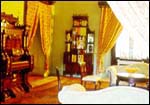
The Wild Land of the Chambal
... in Madhya Pradesh
Text: A Ganesh Nadar. Photographs: Jewella C Miranda and A Ganesh Nadar
 More rooms. And rooms. Stuffed with Scindia possessions. The Tipu Sultan gallery. More antique furniture. More photos. A passage lined with metal statues. A gallery of wooden miniatures, including a train and bullock cart was there. Models of railway engines, fire engines, ships, and temples. More furniture. More intricate wooden carvings. Statues. Ceramics. The Scindias had it all. Evidently.
More rooms. And rooms. Stuffed with Scindia possessions. The Tipu Sultan gallery. More antique furniture. More photos. A passage lined with metal statues. A gallery of wooden miniatures, including a train and bullock cart was there. Models of railway engines, fire engines, ships, and temples. More furniture. More intricate wooden carvings. Statues. Ceramics. The Scindias had it all. Evidently.
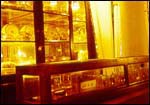 In the dining room was a majestic statue of Madhavrao Scindia Senior. Unfortunately it was covered with gold paint. In the dining room was a majestic statue of Madhavrao Scindia Senior. Unfortunately it was covered with gold paint.
On the staircase leading down there were an array of photographs of tiger hunts, palm trees and the beach. There were also scenes from the palace life.
When you leave the material world of the Scindias you meet up with another security guard. He will ask you for the other half of your entrance ticket. He will let you keep your camera ticket. By the way every time you click a photograph and a member of the palace staff will stop and ask if you bought a camera ticket. Very well trained. They also warn you not to touch the bannisters.
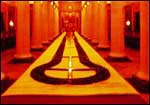 But apparently your museum tour is not over. The security guard will direct you into the next building full of more huge vases and silver statues. Stuffed tigers. Again antique furniture, plenty of it. Huge pink chandeliers. And photos of the royal weddings of the present generation royalty. However this building is worth a visit for the famous wine train which is housed here. This wee train used to circle the ball room during a royal party. If you picked up a wine bottle, it stopped, waited for you to refill and moved on when you replaced the bottle.
But apparently your museum tour is not over. The security guard will direct you into the next building full of more huge vases and silver statues. Stuffed tigers. Again antique furniture, plenty of it. Huge pink chandeliers. And photos of the royal weddings of the present generation royalty. However this building is worth a visit for the famous wine train which is housed here. This wee train used to circle the ball room during a royal party. If you picked up a wine bottle, it stopped, waited for you to refill and moved on when you replaced the bottle.
The back gate is always closed. The Rajmata lives in front of the palace. Madhavrao Scindia lives on the left. There is some distance in between. Both their secretaries are still called ADCs. The ADC is very polite. The palace will definitely leave a lasting impression on you.
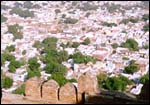 Now head for the fort. You cannot take an autorickshaw up to the fort. You can get dropped off at the bottom and walk up about one and a half kilometre (tough hike) or take a car or bus. The hill is called Urvi Ghati. The drive up – by car -- is very steep. Before you attempt the drive, the cop on duty makes a phone call to check if any vehicle is coming down. There were none and so we were allowed up.
Now head for the fort. You cannot take an autorickshaw up to the fort. You can get dropped off at the bottom and walk up about one and a half kilometre (tough hike) or take a car or bus. The hill is called Urvi Ghati. The drive up – by car -- is very steep. Before you attempt the drive, the cop on duty makes a phone call to check if any vehicle is coming down. There were none and so we were allowed up.
The car stopped a little distance from the fort. The tourism department had a very small shop selling souvenirs. I walked up. On the right, a board announced: sound and light show. This takes place in the evening after dark. To enter the fort you buy a ticket for just Rs 2. This fort was built by Raja Man Singh Tomar (1486-1516).
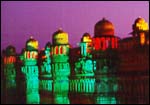 The fort overlooks Gwalior and you have a magnificent view of the city all to yourself. The walls were, of course, huge. Inside there are rooms which have covered balconies. The guide told us that women used to sit in the balcony and listen to the men chatting below. The women, of course, could not be seen and that was the idea behind the covered balcony. The fort overlooks Gwalior and you have a magnificent view of the city all to yourself. The walls were, of course, huge. Inside there are rooms which have covered balconies. The guide told us that women used to sit in the balcony and listen to the men chatting below. The women, of course, could not be seen and that was the idea behind the covered balcony.
There was a museum outside where photography was strictly prohibited. It was filled with sculptures from the 11th and 12th century. Nearly all of them come from Morena district in the heart of the Chambal valley.
Urvi Ghati also had a television tower and relay station. There was the Scindia school and hostel for boys. The students looked smart and healthy. There was also a big gurdwara up there.
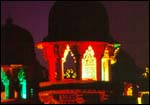 On the way down, again the cop called, to see if the roads were clear. They were not. After a long time a bus from Delhi turned up, followed by a van. We came down very slowly.
On the way down, again the cop called, to see if the roads were clear. They were not. After a long time a bus from Delhi turned up, followed by a van. We came down very slowly.
The drive from Gwalior to the Chambal river took 90 minutes. The road was lined with trees which are called deshi bemur. When we reached the Chambal river the driver took the car half way down the river bed. We decided not to go too close. We walked the rest of the way. The river bank was steep and the sand dry. I slipped and fell. The driver helped me up. A local boy was amused. The driver abused him for not respecting elders and visitors. The boy was not bothered.
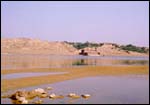 The water was ice cold. When you stand in the river you feel as if history is flowing past you. Your imagination runs wild. You can feel the presence of fierce warriors, daring dacoits and hardened people. There was violence in the air as if any moment horses would gallop down and reduce you to smithereens.
The water was ice cold. When you stand in the river you feel as if history is flowing past you. Your imagination runs wild. You can feel the presence of fierce warriors, daring dacoits and hardened people. There was violence in the air as if any moment horses would gallop down and reduce you to smithereens.
There was a bathing ghat there built by some king long ago... You can take a ride down the Chambal. Nearby is a pumping station which sends water to neighbouring Rajasthan. Very unlike Karnataka and Tamil Nadu. There were lorries and tractors picking up sand.
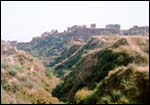 Further down the ravines are deep and foreboding. Where the valley was flat even if it was a small place the local farmers had tilled and planted mustard and toor dal. Women were gathering firewood and goats were grazing. Loads were moving on donkeys.
Further down the ravines are deep and foreboding. Where the valley was flat even if it was a small place the local farmers had tilled and planted mustard and toor dal. Women were gathering firewood and goats were grazing. Loads were moving on donkeys.
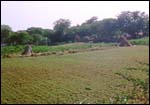 On a nearby hill was a crumbling fort. This area has many forts. Looks like defence was a very important pastime in this area, even centuries ago. I had seen forts in Gwalior, Karera and Datia too.
To see the jungles you had to walk another 15 miles. There are no roads. It is advisable to go in a groups of at least four with a local villager to guide you. All the big time dacoits are either dead or standing for elections. Small time dacoits are guaranteed. A local complained that even when two females fought , the national press labelled it dacoity.
On a nearby hill was a crumbling fort. This area has many forts. Looks like defence was a very important pastime in this area, even centuries ago. I had seen forts in Gwalior, Karera and Datia too.
To see the jungles you had to walk another 15 miles. There are no roads. It is advisable to go in a groups of at least four with a local villager to guide you. All the big time dacoits are either dead or standing for elections. Small time dacoits are guaranteed. A local complained that even when two females fought , the national press labelled it dacoity.
The caste structure is very rigid around here. Everybody votes for his own biradari (clan) and stands by him in fights, however bad he may be as a person.
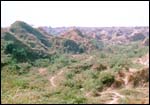 When you cross the bridge over the Chambal river and drive on for a mile you will be in Dholpur which is in Rajasthan. The driver told me that if we drove for another 25 kms we would be in Uttar Pradesh.
If you think there were dacoits only in those days… and they no longer exist… ponder over these two slogans that were chanted with gusto in the last election.
When you cross the bridge over the Chambal river and drive on for a mile you will be in Dholpur which is in Rajasthan. The driver told me that if we drove for another 25 kms we would be in Uttar Pradesh.
If you think there were dacoits only in those days… and they no longer exist… ponder over these two slogans that were chanted with gusto in the last election.
Goli chalegi chathi mein
Mour lagana hathi mein.
(The bullet will strike the chest if you do not vote for the elephant symbol. The man won).
Or
Jeetunga tho lootunga
Harunga tho marunga.
(If I win I will loot the exchequer and if I lose I will kill).
He too won.
Chambal, back
Fast Facts
Tell us what you think of this feature
|




